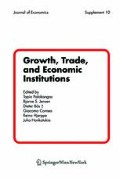Abstract
The New Economic Geography, as expounded by Krugman and others, highlights the importance of greater extent of agglomeration as incomes grow in the world economy. In this paper we suggest an alternative framework in which, as incomes grow, greater degrees of economic fragmentation and dis-agglomeration are encouraged. In both approaches increasing returns to scale are crucial, but in ours these are found in service sectors that allow separate production blocks to be coordinated instead of being found within separate production blocks.
Preview
Unable to display preview. Download preview PDF.
References
Arndt, S, and Kierzkowski, H (eds.) (2001): Fragmentation: New Production and Trade Patterns in the World Economy. Oxford: Oxford University Press.
Basu, S., and Fernald. J. (1997): “Returns to Scale in U.S. Production: Estimates and Implications.” Journal of Political Economy 105: 249–283.
Bennarroch, M. (1997): “Returns to Scale in Canadian Manufacturing: An Interprovincial Comparison.” Canadian Journal of Economics 30: 1083–1103.
Cheng, L., and Kierzkowski, H. (eds.) (2002): Globalization of Trade and Production in South-East Asia. New York: Kluwer Academic Press.
Dixit, A. and Stiglitz, J. (1977): “Monopolistic Competition and Optimum Product Diversity.” American Economic Review 67: 297–308.
Dumais, G,., Ellison, G., and Glaeser, E. (1997): “Geographic Concentration as a Dynamic Process.” NBER Working Paper 6270.
Enke, S. (1951): “Equilibrium among Spatially Separated Markets: Solution by Electric Analogue.” Econometrica 19: 40–47.
Feenstra, R., and Hanson, G. (1997): “Foreign Direct Investment and Relative Wages: Evidence from Mexico’s Maquiladoras.” Journal of International Economics 42: 371–94.
Fujita, M., Krugman, P., and Venables, A. (1999): The Spatial Economy: Cities, Regions and International Trade. Cambridge (Mass.): MIT Press.
Glaeser, E.L. (2000): “The New Economics of Urban and Regional Growth.” In The Oxford Handbook of Economic Geography, edited by G.L. Clark et. al. Oxford: Oxford University Press.
Jones, R.W., and Kierzkowski, H. (1990): “The Role of Services in Production and International Trade: A Theoretical Framework.” In The Political Economy of International Trade, edited by R.W. Jones and Anne Krueger, ch. 3. Oxford: Blackwells.
Jones, R.W., and Kierzkowski, H. (2001a): “A Framework for Fragmentation.” In Fragmentation: New Production and Trade Patterns in the World Economy, edited by S. Arndt and H. Kierzkowski. Oxford: Oxford University Press.
Jones, R.W., and Kierzkowski, H. (2001b), “Horizontal Aspects of Vertical Fragmentation.” in Globalization of Trade and Production in South-East Asia, edited by L. Cheng and H. Kierzkowski. New York: Kluwer Academic Press.
Krugman, P. (1991): “Increasing Returns and Economic Geography.” Journal of Political Economy 99: 483–99.
Marshall, A. (1890): Principles of Economics. Book Four: The Agents of Production: Land, Labour, and Capital and Organization, Chapter 11, “Industrial Organization Continued. Production on a Large Scale” available on the Internet at: http://www.marxists.org/reference/subject/economics/marshall/bk4ch11.htm.
Martin, R., and Sunley, P. (1996): “Paul Krugman’s Geographical Economics and its Implications for Regional Development Theory: A Critical Assessment.” Economic Geography 72: 259–292.
Neary, J.P. (2001): “Of Hype and Hyperbolas: Introducing the New Economic Geography.” Journal of Economic Literature 39: 536–561.
Ng, F., and Yeats, A. (2001): “Production Sharing in East Asia: Who Does What for Whom and Why?” In Globalization of Trade and Production in South-East Asia, edited by L. Cheng and H. Kierzkowski. New York: Kluwer Academic Press.
Ohlin, B., Hesselborn, P.O., and Wijkman, P.M. (eds.) (1977): The International Allocation of Economic Activity. The Nobel Foundation.
Porter, M.E. (2000): “Locations, Clusters, and Company Strategy.” In The Oxford Handbook of Economic Geography, edited by G.L. Clark et. al. Oxford: Oxford University Press.
Samuelson, P.A. (1952): “Spatial Price Equilibrium and Linear Programming.” American Economic Review 42: 283–303.
Samuelson, P.A. (1954): “The Transfer Problem and Transport Costs: The Terms of Trade when Impediments are Absent.” Economic Journal 64: 278–304.
Sheppard, E. (2001): “How Economists Think: about Geography, for Example.” Journal of Economic Geography 1: 131–136.
Sunley, P. (2001): “What’s behind the Models?” in Critical Forum. Journal of Economic Geography 1: 136–139.
Urban, D. (2001): “The Special Economy: One New Economic Geographer’s View.” Journal of Economic Geography 1: 146–152.
Vernon, R. (1966): “International Investment and International Trade in the Product Cycle.” Quarterly Journal of Economics 80: 190–207.
Wan, H., Jr. (2001): “Function vs. Form in the Fragmented Industrial Structure: Three Examples from Asia Pacific Experience.” In Globalization of Trade and Production in South-East Asia, edited by L. Cheng and H. Kierzkowski. New York: Kluwer Academic Press.
Yeats, A. (2001), “Just How Big is Global Production Sharing?” In Fragmentation: New Production and Trade Patterns in the World Economy, edited by S. Arndt and H. Kierzkowski. Oxford: Oxford University Press.
Author information
Authors and Affiliations
Editor information
Editors and Affiliations
Rights and permissions
Copyright information
© 2005 Springer-Verlag
About this chapter
Cite this chapter
Jones, R.W., Kierzkowski, H. (2005). International Trade and Agglomeration: An Alternative Framework. In: Palokangas, T., Jensen, B.S., Bös, D., Corneo, G., Hjerppe, R., Honkatukia, J. (eds) Growth, Trade, and Economic Institutions. Journal of Economics, vol 10. Springer, Vienna. https://doi.org/10.1007/3-211-26650-X_1
Download citation
DOI: https://doi.org/10.1007/3-211-26650-X_1
Received:
Revised:
Publisher Name: Springer, Vienna
Print ISBN: 978-3-211-00793-8
Online ISBN: 978-3-211-26650-2
eBook Packages: Business and Economics

